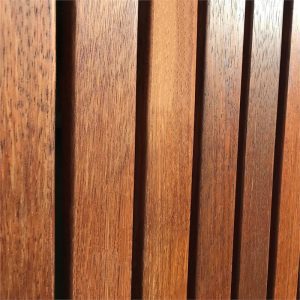Timber Decks: Hardwood Breakdown
Are you building a deck? Browse our latest article for advice on which timber to use for which deck. In this article we discuss the aesthetics, price and longevity of several types of hardwood.
Kwila
Cost ★★★★
Logetivity ★★★★
Aesthetic ★★★★
We install more Kwila hardwood decking than any other timber – by far. The reasons are simple – it looks great, lasts forever and it’s pretty cost-effective. Kwila has a naturally rich red colour, which can be maintained by oiling or left to silver off with age. It’s a highly stable timber and isn’t prone to warping, cupping or splitting. The only downside of Kwila is that during its first few rains outside, it will bleed oils onto adjacent hard surfaces. This can be managed by an experienced installer. There are also a number of products on the market which quickly and effectively remove any staining caused by the tannins.
 Purpleheart
Purpleheart
Cost ★★
Logetivity ★★★★★
Aesthetic ★★★★★
Purpleheart is a rich, purple timber that is absolutely fantastic for decking. It’s heavily favoured for marine applications. It will outlast any other product on the market, especially if it’s near water. It does have a slight tendency to cup over time, but it is supplied with a ‘watershed’ profile to offset this. While oiling will maintain the Purple colouring, Purpleheart does fade to a beautifully sophisticated silver that is generally favoured by clients. After all, why buy the most durable decking available and then spend every spring oiling it?
Pine
Cost ★★★★★
Logetivity ★★
Aesthetic ★★★
Pinus radiata is the most prolifically grown timber in New Zealand and is used in many hardwood decks. Pine decking is the cheapest available. It comes in long lengths which is great for DIY users who want to avoid cutting as much as possible. In all honesty, that’s about all the good you could say about Pine decking. Pine is soft and prone to splitting, shrinking and warping. It has a pale colour and doesn’t age gracefully. The primary reason we hear that people select Pine decking is cost. We try to stress that this can be a false economy. While the decking maybe 10% cheaper, it won’t look nearly as good and will only last half the time before it looks tired and ready for replacement. However, if you are planning to paint your decking in the style of a traditional veranda, Pine may be a good option. This is because it takes paint well and a good coat of paint offers some protection against the elements.
Composite
Cost ★★
Logetivity ★★★★
Aesthetic ★★★
The last of the main options to discuss is composite decking. Composite decking has risen to some prominence in recent years and is made from recycled products including plastic, fibreglass and sawdust. Composite decking proponents argue that it’s stable over time and environmentally friendly. While the environmental benefits of recycling are hard to argue, the decking doesn’t act as a carbon sink. On top of that, in my experience, many composites still demonstrate the warping and shrinkage associated with timber and have an undeniably plastic look and feel to them. The low-maintenance nature of composite products do make them an ideal product for some commercial applications, but my advice is to make sure you’re happy with the aesthetic before locking it in.

 Purpleheart
Purpleheart
